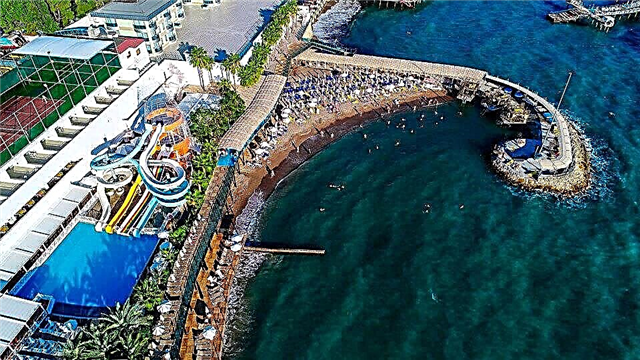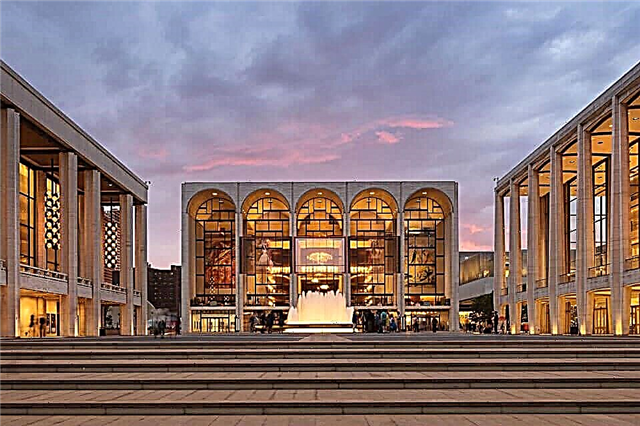Address: Germany, Berlin, district Charlottenburg
Start of construction: 1696 year
Completion of construction: 1699 year
Architect: Johann Arnold Nering
Coordinates: 52 ° 31'15.2 "N 13 ° 17'43.5" E
Content:
When the word “palace” is mentioned, most of the people throughout the post-Soviet space come to mind such majestic creations as the Hermitage, the Winter Palace or Vorontsov in St. Petersburg, the Grand Kremlin Palace or the Grand Tsaritsyn Palace in Moscow.

A bird's eye view of the palace
Naturally, there are other architectural masterpieces in the world that deserve close attention from those people who are not indifferent to the "beautiful and luxurious" history of the powerful. This article will focus on a magnificent building, made in an exquisite Baroque architectural style, with a beautiful name, consonant with the female name Charlotte - Charlottenburg Palace.
Charlottenburg Palace - construction history
Before we start talking about the very construction of this truly magnificent building, I would like to touch on the events that accompanied its appearance. The history of the palace dates back to the middle of the 17th century, from the reign of King Frederick I... His wife Sophia-Charlotte, unlike many ladies of noble blood who loved various receptions, balls and celebrations, absolutely did not recognize entertainment with a large number of people. Her soul was pleased with self-improvement, so she enthusiastically read literature, drawing from it all the most important and interesting. In addition, Sophia-Charlotte was very fond of everything related to music, and playing the harp was one of her favorite pastimes. Seeing how far her spouse is from the bright and, at times insidious, court life, her husband Frederick I decided to build a separate residence for her in a secluded place.

Facade of the palace
To do this, he chose the village of Litzov in the west of Berlin, where, in fact, in 1699, a small summer residence of the queen was built, the entrance to which was decorated with a statue of the Great Elector Friedrich Wilhelm, who was sitting on a horse, the father of Frederick III, cast in bronze.
1701 was a significant year for Frederick. It was in this year that he became the first Prussian king Frederick I, and Sophia-Charlotte became the first Prussian queen. The small palace in Litzi did not in any way correspond to such a high position of the spouses who love each other. For this reason, the newly-made king ordered the transformation of Charlotte's summer residence into a real palace for the queen. Frederick I entrusted the development of the project plan to the then famous architect John Friedrich Eosander. The palace was significantly expanded, and its top was crowned with a domed 48-meter tower, on which a statue of Fortune, made of gold, towered.
To the deep regret of Frederick I, in 1705, Queen Sophia-Charlotte died, barely crossing the threshold of her 37th birthday. I would like to note that this a tragic event and was the reason for the king to rename this palace, which was still called Litzenburg, into the Charlottenburg palace.

View of the palace from the main gate
However, the construction of the Queen's summer residence did not stop after her death. So, from 1705 to 1712, the Great Greenhouse was attached to the palace, on its western side. Looking ahead, I would like to note that these days in this huge hall concerts and festive events are often held.
The next stage of construction took place in 1740, when Frederick II the Great ascended the throne. On his instructions, the court architect Georges Wenzeslaus von Knobelsdorff further expanded the building of the palace, "adding" a New Wing on the east side of it.
King Frederick Wilhelm III also contributed to the construction of this magnificent palace, adding the Small Greenhouse and a small theater from the west. By the way, today in the hall of the Small Greenhouse there is a restaurant that attracts visitors with exquisite and expensive (how could it be otherwise in the palace?) Dishes.
Practically until the end of the 19th century, the Charlottenburg Palace was the residence of the Prussian monarchs... But the next century was not so "good-natured" to the royal building, one might even say that the palace was haunted by continuous adversity.

View of the palace from the park
The Palace Theater, which until the beginning of the 20th century pleased its owners with new premieres, in 1902 ceased to perform the functions assigned to it by the architect, since its area was occupied by a furniture warehouse. In 1918, when almost the whole world was involved in the hostilities of the First World War, Charlottenburg Palace was used as an infirmary. In 1920, after a decision was made in the country to nationalize property, Charlottenburg passed into the possession of the Office of Palaces and Parks. During the Second World War, the palace, which once served as the queen's apartment, was practically destroyed as a result of bombing and shelling. In some historical documents, you can find a mention of the fact that they even wanted to demolish the palace altogether, after all the valuables were removed from there. By the way, the Germans treasured the palace and its property, therefore, by order of Hitler, most of the property was evacuated in the early 40s. The fact of the matter is that since 1939, the British have been carrying out air raids on Berlin quite often since 1939, and one of the bombs could instantly destroy the pearl of Germany.
However, neither the most terrible wars, which claimed millions of lives, nor political debates, nor pogroms and robberies, could wipe this, in its own way, unique palace from the face of the earth.

West wing of the palace
In 1950, art critic Margaret Kuehne, known in her circles as a "lady with a masculine character" and with strong willpower, decides to take charge of Charlottenburg Palace... Having knocked on the hearts of the administration of her country, in the middle of the 20th century she leads all restoration work aimed at restoring and re-creating the original image of the palace. This large-scale work, in its scope, lasted for several decades, but it is worth noting that periodically and today such work is carried out with enviable regularity.
It is impossible to say that Charlottenburg Palace in the form in which we can see it today is nothing more than a new building. Despite the wars, some of the premises suffered little, thus leaving the opportunity for the restorers to accurately restore the former decor elements from separately surviving elements. Among other things, those interior items that were taken out before the outbreak of hostilities again took their places in the Charlottenburg Palace, providing also the opportunity to "show off" and other valuable things brought here from other destroyed palaces.

Museum of Prehistory and Early History in the Palace
Charlottenburg palace - interior decoration
As soon as visitors to the Charlottenburg Palace step over its threshold, almost everyone freezes in a dumb daze. Truly "expensive" beauty simply dazzles with its magnificence. Numerous large and small rooms ("Golden Hall", "White Hall", private chambers, bathrooms, "Red Living Room", library and many other rooms), alternating, amaze with luxurious objects sparkling in the light of special spotlights and huge chandeliers. These are mirrors of various shapes, crystal, sculptures and furniture dating back to the era of the reign of great kings. The walls are decorated not only with "fabulous" tapestries, but also with a stunning collection of paintings, the ancestor of which was once Frederick the Magnificent, and its successors - his successors.It is impossible not to note the luxurious design of the ceilings, flat and domed, during the work on which were used not only painting, but also plaster moldings, wood carvings, sculptures.
A little above it was mentioned that at present in the Charlottenburg Palace you can see interior items from other palaces. However, it should be noted that it is not possible for a common man to define them.

Palace park
Today Charlottenburg is a museum that warmly opens its doors to its visitors, who came to see with their own eyes all the luxury and splendor for which this palace is famous all over the world, located at the moment on the territory of modern Berlin. I must say that the palace is conditionally divided into separate museums, with their own entrances and exits. In order to visit, for example, the Old Palace and the New Wing, the traveler will need to purchase two tickets. It is impossible to give a recommendation which of the buildings of the palace should be visited in the first place, but we can definitely say that if you have time and a certain amount of money, you should not regret and spend the whole day getting to know the entire palace. By the way, in one day you can only in a hurry go around all the premises of the Charlottenburg Palace, a detailed acquaintance with all its exhibits and interior items will take much more time ...











